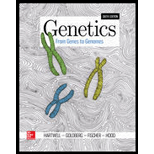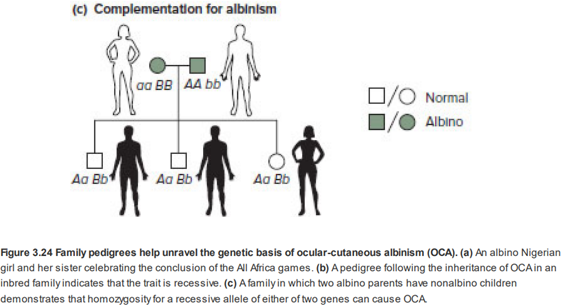
Genetics: From Genes to Genomes
6th Edition
ISBN: 9781259700903
Author: Leland Hartwell Dr., Michael L. Goldberg Professor Dr., Janice Fischer, Leroy Hood Dr.
Publisher: McGraw-Hill Education
expand_more
expand_more
format_list_bulleted
Concept explainers
Textbook Question
Chapter 7, Problem 29P
In humans, albinism is normally inherited in an autosomal recessive fashion. Figure 3.24c in Chapter 3 shows a pedigree in which two albino parents have several children, none of whom is an albino.
| a. | Interpret this pedigree in terms of a complementation test. |
| b. | It is very rare to find examples of human pedigrees such as Figure 3.24c that in effect represent a complementation test. The reason is that most genetic conditions in humans are rare, so it is highly unlikely that unrelated people with the same condition would mate. In the absence of complementation testing, what kinds of experiments could be done to determine whether a particular human disease phenotype can be caused by mutations at more than one gene? |
| c. | Complementation testing requires that the two mutations to be tested are both recessive to wild type. Suppose that two dominant mutations cause similar |

Expert Solution & Answer
Want to see the full answer?
Check out a sample textbook solution
Students have asked these similar questions
I would like to see a professional answer to this so I can compare it with my own and identify any points I may have missed
what key characteristics would you look for when identifying microbes?
If you had an unknown microbe, what steps would you take to determine what type of microbe (e.g., fungi, bacteria, virus) it is? Are there particular characteristics you would search for? Explain.
Chapter 7 Solutions
Genetics: From Genes to Genomes
Ch. 7 - The following is a list of mutational changes. For...Ch. 7 - What explanations can account for the following...Ch. 7 - The DNA sequence of one strand of a gene from...Ch. 7 - Among mammals, measurements of the rate of...Ch. 7 - Over a period of several years, a large hospital...Ch. 7 - Suppose you wanted to study genes controlling the...Ch. 7 - In a genetics lab, Kim and Maria infected a sample...Ch. 7 - The results of the fluctuation test Fig. 7.5 were...Ch. 7 - The following pedigree shows the inheritance of a...Ch. 7 - Autism is a neurological disorder thought to be...
Ch. 7 - Like the yellow Labrador retrievers featured in...Ch. 7 - Remember that Balancer chromosomes prevent the...Ch. 7 - Figure 7.14 shows examples of base substitutions...Ch. 7 - Figure 7.14a shows the mutagen 5-bromouracil 5-BU,...Ch. 7 - So-called two-way mutagens can induce both a...Ch. 7 - In 1967, J. B. Jenkins treated wild-type male...Ch. 7 - When a particular mutagen identified by the Ames...Ch. 7 - Prob. 18PCh. 7 - The Ames test uses the reversion rate His- to His...Ch. 7 - The mutant FMR-1 allele that causes fragile X...Ch. 7 - The physicist Stephen Hawking, famous for his...Ch. 7 - Aflatoxin B1 is a highly mutagenic and...Ch. 7 - In human DNA, 70 of cytosine residues that are...Ch. 7 - Bromodeoxyuridine BrdU is a synthetic nucleoside...Ch. 7 - Albinism in animals is caused by recessive...Ch. 7 - a. In Figure 7.22b, what can you say about the...Ch. 7 - Imagine that you caught a female albino mouse in...Ch. 7 - Plant breeders studying genes influencing leaf...Ch. 7 - In humans, albinism is normally inherited in an...Ch. 7 - a. Seymour Benzers fine structure analysis of the...Ch. 7 - a. You have a test tube containing 5 ml of a...Ch. 7 - Prob. 32PCh. 7 - The rosy ry gene of Drosophila encodes an enzyme...Ch. 7 - Nine rII- mutants of bacteriophage T4 were used in...Ch. 7 - In a haploid yeast strain, eight recessive...Ch. 7 - In Problem 24, you learned that Bloom syndrome is...Ch. 7 - The pathway for arginine biosynthesis in...Ch. 7 - In corn snakes, the wild-type color is brown. One...Ch. 7 - In a certain species of flowering plants with a...Ch. 7 - The intermediates A, B, C, D, E, and F all occur...Ch. 7 - In each of the following cross schemes, two...Ch. 7 - Prob. 42PCh. 7 - The following complementing E. coli mutants were...Ch. 7 - In 1952, an article in the British Medical Journal...Ch. 7 - Mutations in an autosomal gene in humans cause a...Ch. 7 - Antibodies were made that recognize six proteins...Ch. 7 - Prob. 47PCh. 7 - Prob. 48PCh. 7 - In addition to the predominant adult hemoglobin,...Ch. 7 - Most mammals, including New World primates such as...Ch. 7 - Humans are normally trichromats; we have three...
Knowledge Booster
Learn more about
Need a deep-dive on the concept behind this application? Look no further. Learn more about this topic, biology and related others by exploring similar questions and additional content below.Similar questions
- avorite Contact avorite Contact favorite Contact ୫ Recant Contacts Keypad Messages Pairing ง 107.5 NE Controls Media Apps Radio Nav Phone SCREEN OFF Safari File Edit View History Bookmarks Window Help newconnect.mheducation.com M Sign in... S The Im... QFri May 9 9:23 PM w The Im... My first.... Topic: Mi Kimberl M Yeast F Connection lost! You are not connected to internet Sigh in... Sign in... The Im... S Workin... The Im. INTRODUCTION LABORATORY SIMULATION Tube 1 Fructose) esc - X Tube 2 (Glucose) Tube 3 (Sucrose) Tube 4 (Starch) Tube 5 (Water) CO₂ Bubble Height (mm) How to Measure 92 3 5 6 METHODS RESET #3 W E 80 A S D 9 02 1 2 3 5 2 MY NOTES LAB DATA SHOW LABELS % 5 T M dtv 96 J: ப 27 כ 00 alt A DII FB G H J K PHASE 4: Measure gas bubble Complete the following steps: Select ruler and place next to tube 1. Measure starting height of gas bubble in respirometer 1. Record in Lab Data Repeat measurement for tubes 2-5 by selecting ruler and move next to each tube. Record each in Lab Data…arrow_forwardCh.23 How is Salmonella able to cross from the intestines into the blood? A. it is so small that it can squeeze between intestinal cells B. it secretes a toxin that induces its uptake into intestinal epithelial cells C. it secretes enzymes that create perforations in the intestine D. it can get into the blood only if the bacteria are deposited directly there, that is, through a puncture — Which virus is associated with liver cancer? A. hepatitis A B. hepatitis B C. hepatitis C D. both hepatitis B and C — explain your answer thoroughlyarrow_forwardCh.21 What causes patients infected with the yellow fever virus to turn yellow (jaundice)? A. low blood pressure and anemia B. excess leukocytes C. alteration of skin pigments D. liver damage in final stage of disease — What is the advantage for malarial parasites to grow and replicate in red blood cells? A. able to spread quickly B. able to avoid immune detection C. low oxygen environment for growth D. cooler area of the body for growth — Which microbe does not live part of its lifecycle outside humans? A. Toxoplasma gondii B. Cytomegalovirus C. Francisella tularensis D. Plasmodium falciparum — explain your answer thoroughlyarrow_forward
- Ch.22 Streptococcus pneumoniae has a capsule to protect it from killing by alveolar macrophages, which kill bacteria by… A. cytokines B. antibodies C. complement D. phagocytosis — What fact about the influenza virus allows the dramatic antigenic shift that generates novel strains? A. very large size B. enveloped C. segmented genome D. over 100 genes — explain your answer thoroughlyarrow_forwardWhat is this?arrow_forwardMolecular Biology A-C components of the question are corresponding to attached image labeled 1. D component of the question is corresponding to attached image labeled 2. For a eukaryotic mRNA, the sequences is as follows where AUGrepresents the start codon, the yellow is the Kozak sequence and (XXX) just represents any codonfor an amino acid (no stop codons here). G-cap and polyA tail are not shown A. How long is the peptide produced?B. What is the function (a sentence) of the UAA highlighted in blue?C. If the sequence highlighted in blue were changed from UAA to UAG, how would that affecttranslation? D. (1) The sequence highlighted in yellow above is moved to a new position indicated below. Howwould that affect translation? (2) How long would be the protein produced from this new mRNA? Thank youarrow_forward
- Molecular Biology Question Explain why the cell doesn’t need 61 tRNAs (one for each codon). Please help. Thank youarrow_forwardMolecular Biology You discover a disease causing mutation (indicated by the arrow) that alters splicing of its mRNA. This mutation (a base substitution in the splicing sequence) eliminates a 3’ splice site resulting in the inclusion of the second intron (I2) in the final mRNA. We are going to pretend that this intron is short having only 15 nucleotides (most introns are much longer so this is just to make things simple) with the following sequence shown below in bold. The ( ) indicate the reading frames in the exons; the included intron 2 sequences are in bold. A. Would you expected this change to be harmful? ExplainB. If you were to do gene therapy to fix this problem, briefly explain what type of gene therapy youwould use to correct this. Please help. Thank youarrow_forwardMolecular Biology Question Please help. Thank you Explain what is meant by the term “defective virus.” Explain how a defective virus is able to replicate.arrow_forward
- Molecular Biology Explain why changing the codon GGG to GGA should not be harmful. Please help . Thank youarrow_forwardStage Percent Time in Hours Interphase .60 14.4 Prophase .20 4.8 Metaphase .10 2.4 Anaphase .06 1.44 Telophase .03 .72 Cytukinesis .01 .24 Can you summarize the results in the chart and explain which phases are faster and why the slower ones are slow?arrow_forwardCan you circle a cell in the different stages of mitosis? 1.prophase 2.metaphase 3.anaphase 4.telophase 5.cytokinesisarrow_forward
arrow_back_ios
SEE MORE QUESTIONS
arrow_forward_ios
Recommended textbooks for you
 Human Heredity: Principles and Issues (MindTap Co...BiologyISBN:9781305251052Author:Michael CummingsPublisher:Cengage Learning
Human Heredity: Principles and Issues (MindTap Co...BiologyISBN:9781305251052Author:Michael CummingsPublisher:Cengage Learning Human Biology (MindTap Course List)BiologyISBN:9781305112100Author:Cecie Starr, Beverly McMillanPublisher:Cengage Learning
Human Biology (MindTap Course List)BiologyISBN:9781305112100Author:Cecie Starr, Beverly McMillanPublisher:Cengage Learning Biology: The Dynamic Science (MindTap Course List)BiologyISBN:9781305389892Author:Peter J. Russell, Paul E. Hertz, Beverly McMillanPublisher:Cengage Learning
Biology: The Dynamic Science (MindTap Course List)BiologyISBN:9781305389892Author:Peter J. Russell, Paul E. Hertz, Beverly McMillanPublisher:Cengage Learning Biology (MindTap Course List)BiologyISBN:9781337392938Author:Eldra Solomon, Charles Martin, Diana W. Martin, Linda R. BergPublisher:Cengage Learning
Biology (MindTap Course List)BiologyISBN:9781337392938Author:Eldra Solomon, Charles Martin, Diana W. Martin, Linda R. BergPublisher:Cengage Learning Biology Today and Tomorrow without Physiology (Mi...BiologyISBN:9781305117396Author:Cecie Starr, Christine Evers, Lisa StarrPublisher:Cengage Learning
Biology Today and Tomorrow without Physiology (Mi...BiologyISBN:9781305117396Author:Cecie Starr, Christine Evers, Lisa StarrPublisher:Cengage Learning

Human Heredity: Principles and Issues (MindTap Co...
Biology
ISBN:9781305251052
Author:Michael Cummings
Publisher:Cengage Learning

Human Biology (MindTap Course List)
Biology
ISBN:9781305112100
Author:Cecie Starr, Beverly McMillan
Publisher:Cengage Learning

Biology: The Dynamic Science (MindTap Course List)
Biology
ISBN:9781305389892
Author:Peter J. Russell, Paul E. Hertz, Beverly McMillan
Publisher:Cengage Learning

Biology (MindTap Course List)
Biology
ISBN:9781337392938
Author:Eldra Solomon, Charles Martin, Diana W. Martin, Linda R. Berg
Publisher:Cengage Learning

Biology Today and Tomorrow without Physiology (Mi...
Biology
ISBN:9781305117396
Author:Cecie Starr, Christine Evers, Lisa Starr
Publisher:Cengage Learning

Mitochondrial mutations; Author: Useful Genetics;https://www.youtube.com/watch?v=GvgXe-3RJeU;License: CC-BY